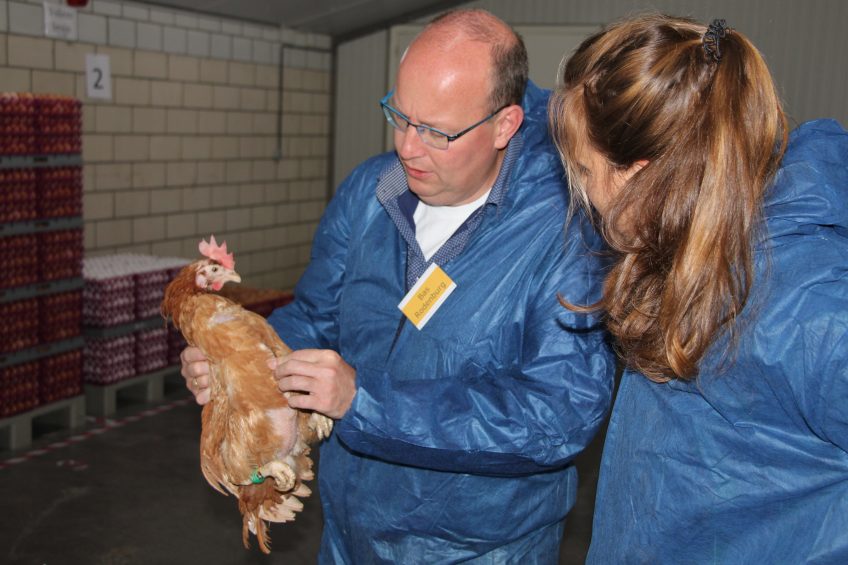Preventing keel bone damage

According to experts from all over Europe, keel bone damage is a multifactorial problem in laying hens. A problem that can be reduced to a large extent. Results of various studies clearly show the problems and also possible solutions.
During a recently held special training day ‘Keel bone damage in laying hens’ at the Experimental Poultry Research Centre in Belgium the latest insights were shared. One of the first speakers was the UK Prof John Tarlton, Professor of Regenerative Medicine at the University of Bristol. Prof Tarlton specialises in skeletal diseases. According to him the poultry skeleton shares specific adaptations for egg production in common with dinosaurs, namely medullary bone. This non-structural bone, which forms in the medullary cavity of long bones, is a labile reservoir of calcium used in the production of eggshells.
Prof Tarlton stated: “My core argument is that the ancestral chicken, the red jungle foul, lays about 12-20 eggs per year, whereas our commercial layers lay around 350 eggs per year. Therefore, a commercial hen needs over 800 grams of calcium per year, which represents 30 times its total skeletal calcium. In order to achieve this, a commercial layer daily exchanges 10% of her total amount of Ca for making eggs.” This is only possible thanks to the presence of medullary bone. This calcium reservoir forms shortly before the egg production starts, in other words when the hen becomes sexually mature.
How much Ca is used from the diet and how much is mobilised from the medullary bone, in order to produce an egg shell, depends on the quantity of calcium that is available in the bone at the time that the shell is formed. Prof Tarlton said: “As hens have only limited Ca reserves in their bones, this should be replenished by the daily feed intake. As a layer extracts Ca from the Ca reserves in her bones mainly at night, a lack of dietary Ca can lead to mobilisation from structural bone in addition to medullary bone. Loss of structural bone can lead to bone weakness, particularly as this reserve is not as readily replenished as the more labile medullary bone.”

Therefore, increasing the availability of calcium in the feed may reduce the loss of calcium from the bone. For example a ratio 75% calcium from feed and 25% from the medullary bone is better than a 60% – 40% ratio, because that demands less of the hen. Also giving grove lime or grit shells can contribute, as the nature of the Ca is also important. According to research from 2016 by Robert Pottgüter of Lohmann, the ration of laying hens must contain between 2 – 2.5% Ca. The grain size also appears to have influence; a Ca-grain of 0.8 mm gives better Ca absorption than a very fine grain.
Omega 3 works
The mechanical functioning of a bone can be divided into three phases according to Prof Tarlton. Firstly, low levels of loading results in little force being applied to the bone. Secondly, greater loading in the so-called ‘elastic phase’ puts stress on the bone, but the bone is able to fully recover. Finally, with still greater load in the so-called ‘plastic phase’ the bone suffers irreversible damage, which will require some repair and may result in a fracture. “Our research shows that the bone of poultry in non-cage systems does in fact gradually get stronger throughout lay, but not sufficient to withstand the hazards the hens are exposed to in the laying environment.” A solution in this context according to Prof Tarlton is adding Omega 3 fatty acids to the feed. Omega 3 can easily be given in the form of linseed or fishmeal, which is beneficial in preventing bone loss. By giving Omega 3 the incidence of the fractures is lowered from 65% to 25% at 50 weeks and 70% to 40% at 70 weeks of age.
Bone becomes stronger in response to loading, providing this remains in the ‘elastic phase’. Prof Tarlton says: “So it’s a dynamic system, with bone becoming stronger when exposed to increased loading, for example through exercise, and weaker when loading is reduced, for instance when hens are kept in restrictive environments such as battery cages.” There are several local and systemic regulators which regulate the function of bone cells and calcium metabolism. These include growth hormones, thyroid hormones, estrogens, calcium levels and vitamin D. Prof Tarlton says: “In terms of maintaining a healthy skeleton, vitamin D is central, as this regulates bone cell function, absorption of calcium in the gut and calcium secretion in the kidneys.”
System set-up important
Now it’s true that more exercise or training of the hen leads to stronger bones, but there’s also the so-called ‘hazard paradox’ according to the Dutch Proffesor Bas Rodenburg of the Department of Animals in Science and Society of the Faculty of Veterinary medicine of Utrecht University. “In complex aviary systems the hen can certainly move a lot more than in cage systems, but the risk of fractures is also greater. For example, because they fly into something or fall down. The risk of defects may incidentally be smaller by specific adaptations of the aviary system.” According to research by Dr Jasper Heerkens of the ILVO in Gent it appears that a portal aviary system is safer for hens than a traditional aviary system in rows. For example, in a portal system the incidence of fractures in the middle of the keel bone was 13% lower than in a system with rows. And in the case of installing in rows, the distance between the rows also affects the amount of damage by the hens. White hens could possibly manage a greater jumping distance than brown hens because of their lower body weight and better motor abilities. The prevalence of keel bone damage in an aviary system with plastic flooring was lower, compared to an aviary system with metal grids (76.1% versus 85.5%).

Prof Rodenburg: “Also adding platforms and ramps in the top of the aviary system results in a decrease of fractures. This was proven in research by Dr Ariane Stratmann from the University of Bern. Extra ramps in the top of the system resulted in 45% fewer falls, 59% fewer collisions and for no less than 23% fewer fractures compared with a system without extra ramps. Vencomatic is, for example, already working with steps at the top of the system.” Research by the University of Guelph in Canada in 2016 shows that the angle of ramps placed in systems must be smaller than 40°. Prof Rodenburg: “What is striking is that this research shows that a stair consisting of a metal grid is used better by rearing hens than a rough, sandpaper-like surface.” Older research shows that the angle between the various perches is also important. When an angle in the system is greater than 30°, the hens are more reluctant to jump down and are more likely to have an accident (in 22% versus 5% of the cases). The research shows that, especially in places where the hen jumps down, the angle must be less than 45º. By jumping up the hen has a smaller chance of damage than by jumping down.
Good rearing important
The rearing phase is very important to prevent keel bone damage. Research by the University of Guelph in Canada in 2016 shows that young hens who are raised in a rearing aviary system are better developed, in terms of motor skills, than animals reared in cages. Prof Rodenburg: “This especially applies to less fractures, on deformations of the bone it has virtually no impact.” Genetics also play a role. White hybrids seem to move better around in an aviary system than brown hybrids. Prof Rodenburg: “Even though white hybrids have a greater theoretical risk of fractures than brown hens, because they have a lighter bone system, they seem to have a smaller chance of fractures than brown hens in day to day life. That’s because white hybrids are lighter, more active and fly easier. Research by Dr Heerkens from 2016 show that brown crossings on average had more breaks in the keel bone than white hybrids. Brown hybrids also had more fractures in the tip of the keel bone than white hybrids.” Research by Dr Stratmann from 2016 showed a relationship between bone strength and risk of fractures. She found much less bone fractures in a white line selected on high bone strength compared to a line selected on low bone strength, showing there is scope for genetic selection against keel bone damage.

Perch design has big impact
Anneleen Watteyn, scientific researcher at the Flemish research institute ILVO in Belgium: “From research by Gregory et al. in 1989 and Rodenburg et al. in 2008, it is clear that in non-cage systems the damage, especially in the form of fractures, is considerably greater than in cage systems. The fractures are also more serious than in non-cage systems.” A research conducted by Dr Heerkens in 2016 whereby 47 flocks all from Belgium or the Netherlands were involved and many types of aviary systems, it turned out that the most damage is found in the middle part of the keel bone. Prevalence of hens with keel bone fracture was on average 82.5%. There are various causes for the occurrence of the damage according to Ms Watteyn. “This can be genetics, behaviour, physiology, but also design of the aviary system. So it also depends on the number of ramps and platforms and from what material they are made.” Perches are important for the natural behaviour of a hen, but they also provide increased pressure on the sternum by the hen because of sitting sometimes for long periods. Ms Watteyn: “A metal perch is harder than wood, but wood again is more sensitive to red mite infestations.” Research by Dr Stratmann shows that perches with PU-foam around them make sure that the energetic impact is lower, in case the hens fly against it. In addition, PU-foam provides for more grip whereby the hens fall less of the perches.
Because of the larger diameter of the perch, the pressure on the keel bone will be more spread. All this reduces the number of deviations and fractures. PU-foam again is, however, a risk from hygiene and/or red mite perspective. According to Ms Watteyn research from the University of Guelph in Canada demonstrated that encouraging the hens during the rearing phase is not only important because they get stronger muscles and bones, but also because the hen gets a better spatial insight (3D). The use of ramps in itself is beneficial of reducing keel bone damage, the gains are greater than the risks.













